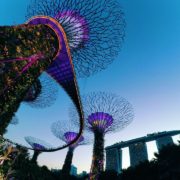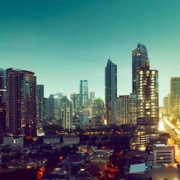How Signify is Creating Healthier Workspaces with Light
The pandemic has placed an unprecedented emphasis on the importance of supporting employees’ physical and mental health. But how do we know if one building has a ‘healthier’ design than another and how does a building’s lighting play a part?
On average, 90% of our time is spent within buildings, of which 36% is spent in the workplace. This makes it crucial for building designs to place both the physical and mental health of occupants as a priority. Research has shown that a workspace in a building designed for the well-being of its occupants can enjoy up to an eight per cent increase in productivity since 90% of business costs are staff-related. Such offices also see 20 per cent fewer workdays missed by employees as they are more emotionally and mentally committed.
As Singapore moves into the post-pandemic era, it has perhaps never been clearer that more needs to be done to holistically enhance building designs for the benefit of the overall well-being of employees and employers. Already, as the country moves to live with COVID-19 as an endemic and more people return to their workplace, there is a growing focus on protecting employees against the virus. The pandemic has also accelerated the urgency for more to be done to safeguard staff mental well-being.
Singapore has been ranked as the unhappiest workforce in the world according to the 2021 global report, “Impact of COVID-19 on Business Owners and Employees”. In fact, on 16 May 2021, when Singapore adopted heightened alert restrictions, the Samaritans of Singapore (SOS) received 40% more calls to their mental health helpline. This has resulted from elevated stress levels associated with lack of social interaction, loss of support from home as well as other factors such as fear of the virus, job uncertainty and difficult living conditions. Well-designed workspaces could play a big role in lowering such anxiety and stress and making employees happier and more productive people.
The Singapore government has been long aware of the importance of building healthier workspaces. In 2018, the Singapore Building and Construction Authority (BCA) introduced the Green Mark for Healthier Workspaces certification scheme in collaboration with the Health Promotion Board (HPB) to cultivate healthier indoor environments that promote employees’ health and well-being in addition to being sustainable. More recently in April 2021, the BCA Green Mark 2021 (GM: 2021) pilot was launched as part of the Singapore Green Building Masterplan, and will fully take effect from 1 November 2021. The GM: 2021 expands upon the previous Green Mark scheme and aims to raise standards in energy performance, place greater emphasis on sustainability and promote outcomes that are aligned with the United Nations’ Sustainable Development Goals (SDG).
It has a section dedicated to Health and Well-being (GM 2021 Hw) which involves scoring buildings on the way they are designed, retrofitted, constructed and operated to facilitate the mental, physical and sociological well-being of their occupants. These schemes will be pivotal in ensuring that workspaces in new and existing buildings are designed or redesigned with the wellness of occupants in mind.
The impact of light on a person’s health and well-being
Lighting has a visual, emotional, and biological impact on people. It is the main component that drives our visual capabilities and has a psychological and physiological effect as it controls the body’s circadian system which regulates our sleep-wake cycle and affects perception and moods throughout the day. Apart from giving us vision, lighting directly contributes to our comfort and ability to perform tasks. Studies have shown that bad lighting is associated with negative physical and mental health effects.
Natural light, in particular, is known to reduce stress, improve cognitive function, creativity and improve well-being. This has made it a key component of biophilic design – the concept of bringing nature indoors — by including nature in the interior or architectural design. The idea is to use indoor lighting to mimic natural light so as to create a healthy, engaging, and inspiring environment to improve well-being at workspaces. Implementing biophilic design elements enables organizations to use light that optimizes employee health and well-being, resulting in happier, more focused and energetic employees which in turn leads to better productivity.
Light — a key component of the international WELL Building StandardTM
Organizations looking to enhance their workspaces for greater employee well-being can look to the WELL Building StandardTM as a framework. Developed by the International WELL Building Institute (IWBI) and launched in 2014, the WELL Building Standard is a global building standard for health and well-being. Now in its second iteration, WELL v2 continues to encourage a people-first approach to buildings, building upon the foundation laid by the previous WELL standards.
‘Light’ is one of 10 “Standard Concepts” of the Standard. A building that has achieved the WELL certificates indicates its fulfilment of guidelines in nine different lighting design considerations such as “Circadian Lighting Design (L03)” and “Daylight Simulations” — both are major components of biophilic design. Projects that are certified under the WELL Building Standard will also receive recognition and certain exemptions as part of the GM 2021 Hw.
Signify’s lighting technologies support buildings to achieve WELL Building Standard
At Signify, we help companies in achieving the “Light” standard concept of the WELL Building Standard with our innovative products and services. With Signify’s LED lights, organizations will be able to achieve initial lighting preconditions for certification, “Light Exposure” and “Visual Lighting Design”. “Light Exposure” requires the project to provide appropriate light exposure using lighting strategies in indoor settings. On the other hand, “Visual Lighting Design” requires appropriate illuminances on work areas for regular users for all age groups depending on the tasks performed in the space. Signify’s LED lights are visually comfortable, flexible and scalable. With a wide variety of luminaires available, there is a solution that caters to the unique requirements of every type of workplace.
A building in Singapore that has adopted Signify’s solutions as part of its efforts to achieve global standards in promoting the well-being of occupants is Paya Lebar Quarter, a mixed-use development with three office towers. It was the first project in Singapore to register for the WELL Core and Shell Certification in 2017, aligned to its focus on integrating health and wellness components into the building design. Signify supplied the building with Power Balance light fixtures – the most energy-efficient light fitting with about a 140 lumen/watt efficacy, as well as light fixtures from its Modular lighting range.
Paya Lebar Quarter was also the first to achieve a Platinum ranking under the BCA’s Green Mark for Non-Residential Buildings NRB: 2015 in 2017. Lighting matters in the health and well-being of employees for any workspace in the world. Schemes and certifications such as GM 2021 and the WELL Building Standard will pave the way for an organization to take advantage of advancements in lighting to increase the resilience of its people and its business.


